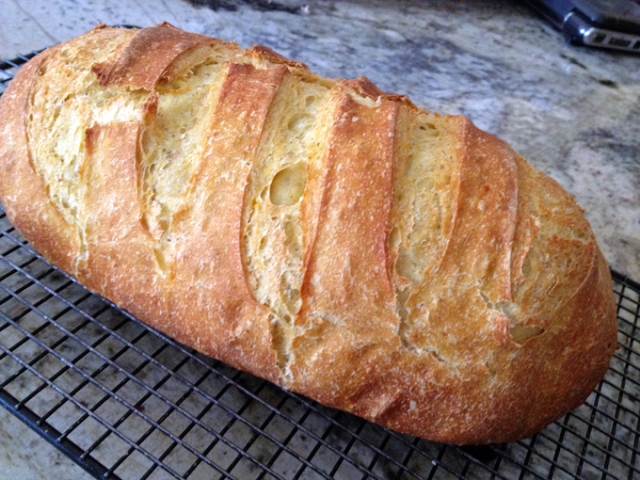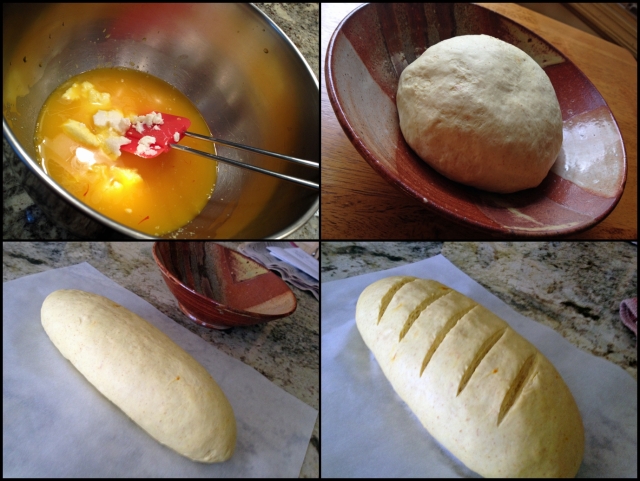Since they say confession is good for the soul, here is mine: I’ve been cheating. Big time. Not only I’ve been baking bread with commercial yeast, but I went one step further down the path of debauchery and grabbed a bottle of “rapid rise” to play with. Just for the fun of it. This bread was ready in less than 3 hours. It had a wonderful texture and tasted amazing too. Sourdough will never leave my world, but I see some other “quickies” in my future.
SUNDRIED TOMATO TWIST BREAD
(adapted from several sources)
3 + 1/2 (420 g) cups all purpose flour, divided
2 1/4 teaspoons (1 package) fast acting yeast (about 7g)
2 teaspoons sugar
1 teaspoons salt
1 + 1/4 cup (280 g) water
1/4 cup (53 g) canola oil
1/2 tablespoon white vinegar
1/4–1/2 cup sundried tomato pesto (store-bought or homemade)
1/3 cup shredded Gruyere cheese (eye-balling is ok)
In the bowl of a stand mixer, combine 2 + 1/2 cups (300 g) flour, yeast, sugar, and salt with a whisk.
Heat water and canola oil until warm (100 F). Add to flour mixture. Add vinegar. Mix roughly with a wooden spoon, then switch to the dough hook and add the remaining flour in small amounts until you get a dough that is smooth and barely sticks to the sides of the bowl. You might not need the full amount of flour, I had just a little bit left.
Knead for about 5 minutes in low-speed. Place in a bowl lightly coated with oil, and let it rise until almost doubled. If using fast-acting yeast, it will take less than one hour.
Grease a 9-inch springform pan, and line bottom with parchment; grease paper. Place on top of a baking sheet. Set aside. Punch down the dough. On a floured surface, roll the dough into a thin rectangle, as thin as you can without tearing it. Spread a thin layer of pesto on top of the dough, leaving a small border without any pesto. Spread the Gruyere cheese all over the pesto. Starting at the long edge, roll it tightly and gently into a log.
Use a bench scraper to cut the dough in half lengthwise. Cross the two halves (layers facing up) to create an X shape; braid top and bottom of dough by laying the left piece over the right keeping the cut side up, until pieces of dough are tightly twisted. Pinch ends together.
Start at the thinner edge and slowly and very gently, roll the braid into a giant snail shell or a very large cinnamon bun. Be careful to keep all the layers facing up. Carefully pick up the shaped bread and place in the prepared springform. Cover; let rise in warm place until almost double. If using fast-acting yeast, it will again be ready in about 40 minutes, or even less, depending on the temperature of your kitchen.
Heat the oven to 400 F as the bread is in its final proofing stage. Bake at 400º for 10 minutes, lower oven temperature to 350º and bake for an additional 30 minutes. When the bread is out of the oven lightly brush olive oil on top and sides. Let cool completely on a rack before slicing.
ENJOY!
to print the recipe, click here
Comments: Amazing how fast that yeast works. Being used to working with sourdough it almost scared me when after what it felt like the blink of an eye I caught the dough almost an inch above the rim. Unreal. A really nice dough to work with thanks to the addition of oil, handles very smoothly, not threatening to tear while rolling out and shaping.
I used store-bought sundried tomato pesto, because I made this bread in a weekend of intense baking and taking a little shortcut was my only real option, but of course making the pesto from scratch would be even better. So many other fillings will be great also. Black olives, pieces of ham or crispy bacon, you can take this bread in many directions. Just try to roll tightly and thinly, so that you get as many little layers as possible.
If you are a novice at bread baking, don’t let the shaping scare you, this is the type of dough that is very forgiving and even if you mess up the shaping a bit, it will look great. You don’t even have to do the twisted shape, you could braid the two halves of the dough, join the ends and call it a day.
Leftovers are superb toasted!
ONE YEAR AGO: And now for something completely different….
TWO YEARS AGO: Parsnip, Coconut, and Lemongrass Soup
THREE YEARS AGO: In My Kitchen, October 2016
FOUR YEARS AGO: Paleo Moussaka
FIVE YEARS AGO: In My Kitchen, October 2014
SIX YEARS AGO: In My Kitchen, October 2013
SEVEN YEARS AGO: Crimson and Cream Turkey Chili
EIGHT YEARS AGO: Taking a break from the nano-kitchen
NINE YEARS AGO: Chocolate Chip Cookies








